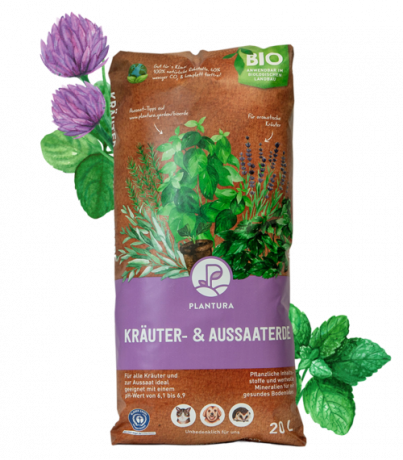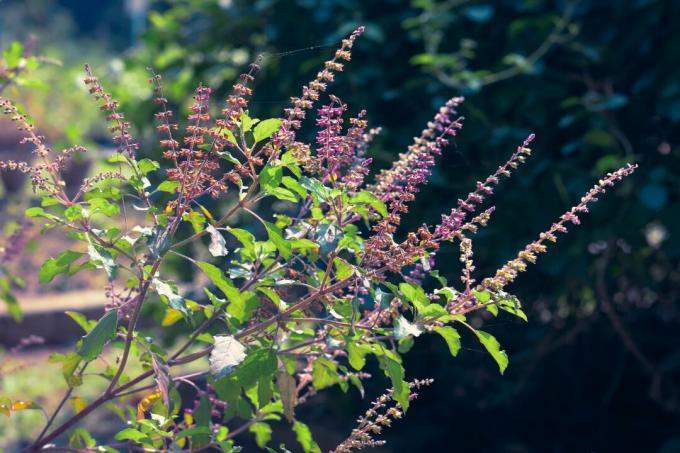Tulsi (also known as Holy Basil) is legendary and also grows very well here. Its spicy-sweet taste not only unfolds in medicinal tea - Tulsi spice and Tulsi pesto are also something special.

Known as the "sacred herb" in Hinduism, tulsi plays a role in religious ceremonies and symbolizes divine protection. Tulsi herb is said to have various medicinal properties and has a unique flavor as a Tulsi tea, spice or oil. With proper care, the plant can also grow here. Find out where tulsi comes from, how to plant it and what to consider when cultivating here.
Contents
- Tulsi: origin and characteristics
- Plant Tulsi
- The right care
- Harvest, uses and effects of tulsi herb
Tulsi: origin and characteristics
Indian basil (Ocimum tenuiflorum Syn. Ocimum sanctum) is a species of the genus Basil (ocimum) and plays a role above all in Asia. It is also known as tulsi, king basil or holy basil and is naturally widespread in tropical and subtropical Asia. Tulsi can grow up to 100 cm tall and is perennial - but not frost tolerant. This basil species has a hairy, slightly reddish stalk on which grow opposite green leaves. These have fine glandular hairs and taper to a point. Contrary to what we know
basil (Ocimum basilicum) the leaves of the Indian basil are serrated. In addition, they are slightly darker and thinner than those of their relatives. As well as Ocimum basilicum forms Tulsi terminal inflorescences. These are 6 to 8 cm long and each contains 6 flowers in false whorls. The Tulsi flower usually has purple and rarely white petals and makes Tulsi an excellent bee pasture. It also exudes a fresh, herbaceous-peppery scent that is reminiscent of cloves. Tulsi herb flowers between June and September and develops brown to black, teardrop-shaped nuts when the fruit is ripe.
Plant Tulsi
The best time to plant tulsi is between May and June after the Ice Saints. For this you should choose a sunny, wind-protected location that has nutrient-rich and loose, airy soil. Very sandy or loamy ground should be avoided. The optimum soil pH is in the neutral range. To enrich the substrate with nutrients, you can mix about a fifth of well-seasoned compost under the soil before planting. Ours, for example, is suitable for planting in a pot Plantura organic tomato & vegetable soil. This is peat-free and ensures healthy plant growth in a sustainable way. The bucket used should hold at least 5 liters of soil and have a drainage hole. Only plant the Indian basil plant deep enough in the ground that the leaves do not touch the ground. You can also plant tulsi outdoors or in a greenhouse, but that's it hardiness zone Assigned to Z10 and accordingly not frost tolerant. So it won't survive the winter outdoors.

You can also sow the Indian basil yourself. The optimal germination temperature is 20 °C, which is why outdoor sowing should only take place in early summer. A preculture from March on a sunny windowsill is better. Proceed as follows:
- First, seed trays with potting soil like our peat-free Plantura Organic Herb & Seed Soil prepared.
- Place the seeds on the ground and gently press them in.
- The seeds are not covered with substrate - Tulsi is a light germinator.
- Then set the seed tray warm and bright.
- The soil should always be kept slightly moist at room temperature, this is best done with a spray bottle. To keep the moisture, you can cover the seed trays with transparent foil. However, this should be removed for a few minutes every day to bring fresh air to the soil and to avoid damping-off or root rot caused by fungi.
- After about 20 days the seeds will germinate. If they are too close together, they can then be pricked out at the two-leaf stage and placed in nutrient-rich substrate.

Organic Herb & Sowing Soil 20 L
- Ideal for herbs as well as for sowing, propagating cuttings and pricking out
- Ensures aromatic herbs & strong young plants with strong roots
- Peat-free & climate-friendly: CO2-reduced organic soil made in Germany
The right care
Caring for a tulsi plant requires a little attention: it is important that the Indian basil never dries out completely and is therefore regularly watered in small quantities. Waterlogging should be avoided. As a rule of thumb, basil should always be watered after the top layer of soil has dried.
Tulsi also has high nutritional requirements compared to most herbs. It should therefore be fertilized again with a long-term fertilizer in granular form, such as ours, when planting and after 2 to 3 months Plantura organic tomato fertilizer be fertilized. Find out more about how in our special article Fertilize basil.
When the tulsi plant is young, branching can be encouraged by cutting off the stem below the top pairs of leaves. A strong specimen that is 2 to 3 years old does not need to be trimmed afterwards. However, pruning always promotes growth and makes the plant a bit bushier.

Is Tulsi Hardy? No, the Indian basil is not hardy and sensitive to frost. Accordingly, it should be placed in a bright room with a temperature of 15 to 20 °C before the first frosts. Read how here Overwinter basil.
Harvest, uses and effects of tulsi herb
Basically, harvesting Tulsi is no different than harvesting Harvesting Basil. Using pruning shears, the shoots are cut back to just above a leaf base. Later, Tulsi will sprout two new shoots from the two leaf axils, making it bushier and bushier. The cut should not be made too deep, because new branches form from already lignified shoots much more slowly than from young, green shoots.
The Tulsi herb has a wide variety of uses, which is why it is worth harvesting between May and August. The herb and the flowers can be drunk as a tea, processed into pesto or used as a spice in Asian dishes. It is also part of the traditional Indian healing art Ayurveda. It is processed both dried and fresh. Its aroma differs significantly from that of the Ocimum basilicum: It is spicy-sweet and slightly peppery.

Holy basil is said to have a variety of medicinal benefits, most likely due to the antioxidants found in the plant. In Asia, Tulsi is used as a medicine. Among other things, it is said to help with diseases in the digestive tract, against stress and sensitivity to cold. It is also said to have an antibacterial effect, strengthen the immune system and help lower cholesterol levels. In Europe, the herb is particularly used as a medicinal tea against the above-mentioned ailments.
If you are more unusual basil varieties want to get to know, read on in our magazine. Did you know it too red basil and black basil gives?
Register now for the Garten-Post and receive great tips, seasonal trends and inspiration on everything to do with the garden from our expert every week.



